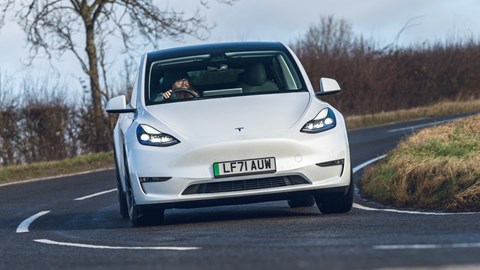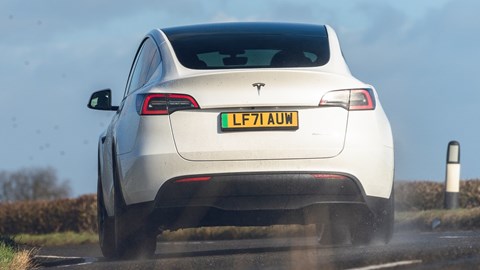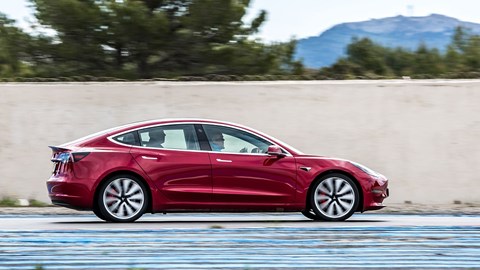► You can now get a Model 3 for £38,790
► But Tesla’s depreciation levels are on the rise
► Cars could lose 46% of their value in a year
Tesla is waging a price war on the EV market. Yet again, the company has slashed the price of its cheapest Model 3 saloon to £38,790, representing a £4,200 saving over the EV’s previously discounted retail figure. However, that saving can only be claimed if you’re prepared to take a Model 3 from stock instead of ordering one directly from the factory.
Tesla last reduced the value of its Model 3 and Model Y in January 2023, lowering their prices by around £7,000 each. Prices for a factory-ordered Model 3 start from £42,990, while the Model Y is priced from £44,990.
This is great news for consumers looking to buy a new Tesla Model 3 – but how will it affect their finances once they’re ready to trade it in for something else? The vehicle valuation service, CAP HPI, reckons the outlook is bleak. It’s forecasting a decline in value for second-hand Teslas, partly thanks to CEO Elon Musk’s volatile pricing strategy.
CAP’s forecasts suggest that a new Tesla Model 3 Long Range, bought in January 2023 for £57,435, will only be worth £31,850 by January 2024 (providing it’s only travelled 10,000 miles). That’s a 44 percent decrease in value over 12 months, which is head and shoulders above the depreciation rates for Tesla’s rival electric car manufacturers.

For the sake of comparison, if you bought a brand-new Kia EV6 GT-Line S in January 2023 for £52,690 and covered the same 10,000 miles over the following 12 months, CAP reckons the car would still be worth £37,300 in January 2024. That’s only a 29 percent drop in value.
Tesla’s poor used values aren’t exactly breaking news, either. In January 2023, CAP HPI was already warning us that one-year-old Tesla Model 3s with around 20,000 miles on the clock had lost £11,600 (or more than 25 percent) of their value since September 2022.
But it isn’t just electric cars suffering from depreciation. CAP reckons that the plug-in hybrid BMW 330e M Sport and Mercedes C 300 e AMG Line will both lose around 30 percent of their as-new price during their first year on the road. That seems like a lot but, crucially, they’ll retain more of their value than an equivalent Tesla Model 3.
Why is Tesla’s depreciation so severe?
Sales of new EVs reached nearly 17% of the UK new-car market in 2022, according to the latest figures. However, the cost-of-living crisis, recessionary pressures and soaring energy bills are headwinds that have made electric cars less attractive in the past 12 months.
With demand for electric cars slowing down, Tesla’s wait times have tumbled from more than a year to a matter of weeks. In March 2023, the company’s configurator reported lead times for the Model 3 to be as short as one month – and only three months in a worst-case scenario. A shorter waiting list could have motivated Tesla to fabricate demand by dropping its prices which, in turn, lowered residuals.
Dylan Setterfield, CAP HPI’s head of forecast strategy, also reckons the astronomical prices of nearly new cars at the tail end of the coronavirus pandemic (right when the semi-conductor shortage was at its peak) is partly to blame for rising depreciation. This downturn is just the other side of the curve.

He said: ‘used values for many battery-electric models were strong through 2022. In many cases, nearly new retail values were above list price, some by a considerable margin. This was clearly unsustainable and our forecasts reflected that, with large negative adjustments applied.
‘In January [2023], the average used value for every battery electric model remains above our forecast from last year. BEV values remained stronger for longer than anticipated in the face of prolonged new car supply issues and are now transitioning to more realistic, sustainable levels.’
Setterfield expects we’ll see further used price drops as the market works through the inflation. He said: ‘For some models, there is more adjustment to come – there are still vehicles with used values above list price and significant reductions are expected in these cases over the coming months.’
How will this depreciation affect new car buyers?
Poor used values could have affect Tesla’s finance deals. When you buy a car using finance, you’re paying for both the car and its depreciation – and if that car will be worth less money at the end of your lease, you’ll pay more money each month to have it on your drive.
It’s a way for the manufacturer to protect itself. If you return your car at the end of your lease, the manufacturer then needs to sell it on the used market – and if the depreciation is too high, it’ll be selling the car at a loss. By paying extra on your leasing deal, you’re creating a buffer for the firm.

Despite how drastic these depreciation figures look, Setterfield isn’t forecasting a total collapse of the EV market just yet. He still reckons they make a lot of financial sense and, although you’ll pay a lot in depreciation, there are still opportunities to save on fuel and maintenance.
He said: ‘the total cost of ownership situation generally remains favourable for BEVs. Even with fuel prices continuing to decline at the pump, any sensible charging regime still sways the economic equation. The implementation and ongoing development of clean air zones is also likely to continue to support demand for used BEVs. The ongoing pricing realignment actually helps in that regard, making BEVs more affordable.’
Why is Tesla cutting its prices?
The company explained its logic in a statement: ‘Our focus on continuous product improvement through original engineering and manufacturing processes have further optimised our ability to make the best product for an industry-leading cost. As we exit what has been a turbulent year of supply chain disruptions, we have observed a normalisation of some of the cost inflation, giving us the confidence to pass these through to our customers.’
Is it a move to shore up its sales in an increasingly competitive market? Almost certainly. Chinese brands, such as Ora and MG, are arriving in Europe with attractively low prices and it’s likely that Tesla is moving defensively to protect its current market dominance. It was the largest EV brand in the UK in 2022 and sold more electric cars than Peugeot, Land Rover, Volvo or Skoda did of all their products, electric or oil powered.
Tesla reviews